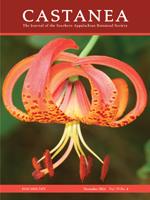In the eastern United States, the practice of salvage logging is common to reclaim economic losses and/or reduce fuel loading following a natural disturbance. A current hypothesis states that two disturbances in rapid succession (i.e., compounded disturbance) have a cumulative severity of impact and may displace the successional trajectory further than either disturbance occurring separately. On 20 April 2011, Bankhead National Forest in Alabama was affected by an EF1 tornado with accompanying straight-line winds. Much of the damage was salvaged, however adjacent disturbance in a Wilderness Area was not harvested. A unique set of conditions allowed for comparisons of woody regeneration within a single stand, reducing uncontrolled variables to test the compounded disturbance hypothesis at a fine spatial scale. After two growing seasons, species richness, species evenness, and Shannon diversity of seedlings and saplings did not significantly differ by disturbance class. We found seedling density significantly differed between functional groups and we noted a significant interaction between functional groups and disturbance classes. In the sapling layer, density was significantly different among functional groups and among disturbance classes, but our results did not reveal a significant interaction between these factors. The wind disturbance accelerated succession in the Quercus stand toward dominance by shade-tolerant species, notably A. rubrum, and the salvage operation amplified the Quercus-to-Acer transition. However, even in wind-disturbed areas that were not salvaged, the regeneration model predicted A. rubrum to have more than twice the density of all combined Quercus species in the future stand.
How to translate text using browser tools
1 December 2014
Woody Regeneration in a Southern Appalachian Quercus Stand Following Wind Disturbance and Salvage Logging
Stephen D. White,
Justin L. Hart,
Lauren E. Cox,
Callie J. Schweitzer
ACCESS THE FULL ARTICLE

Castanea
Vol. 79 • No. 4
December 2014
Vol. 79 • No. 4
December 2014
Acer rubrum
compounded disturbance
Quercus
regeneration
salvage logging




